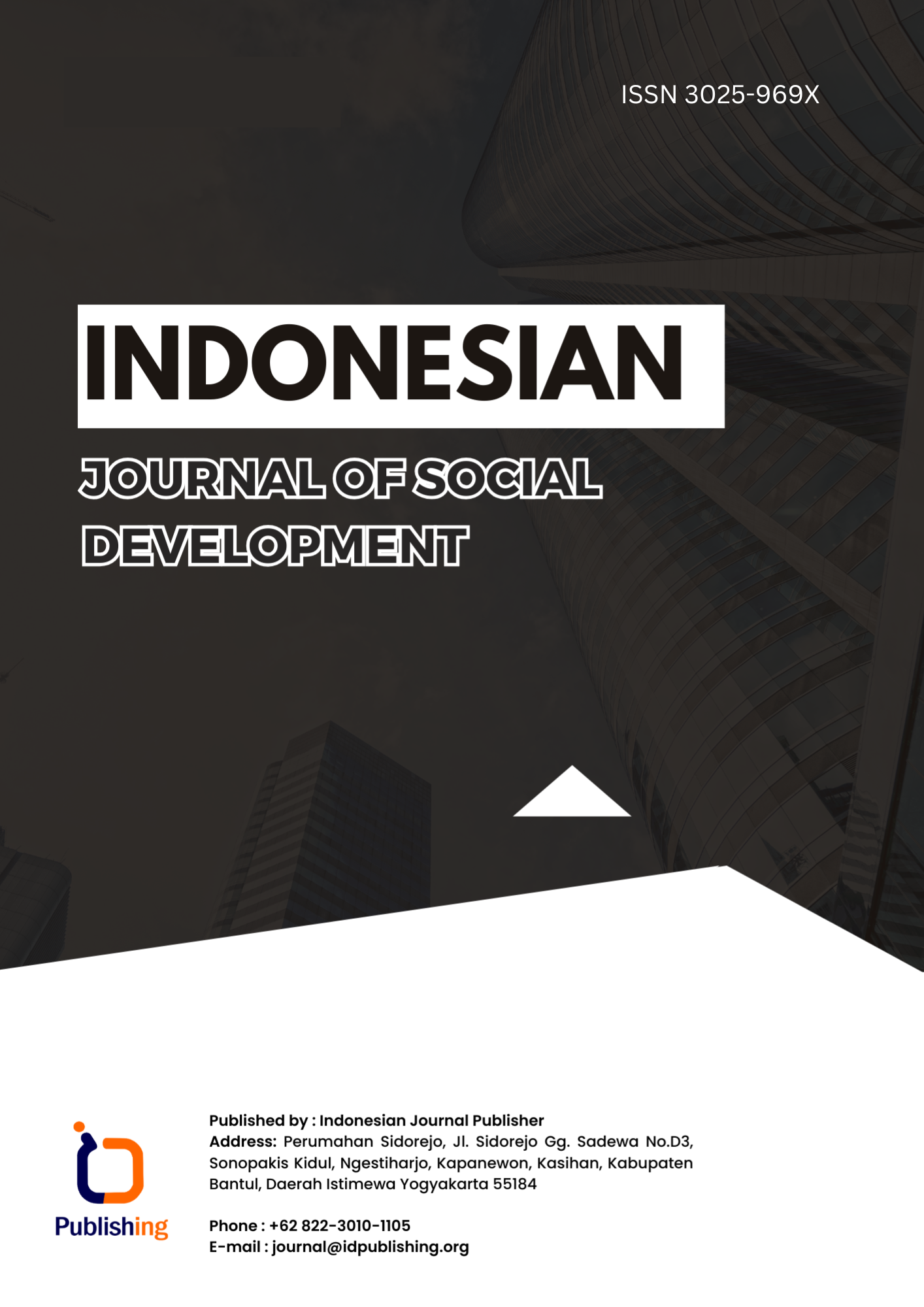From Ritual Practice to Community Resilience: An Ethnographic Study on Local Cultural Strategies in Urban Makassar
DOI:
https://doi.org/10.47134/jsd.v3i1.4538Keywords:
Urban Ritual, Cultural Resilience, Spatial Negotiation, Makassar EthnographyAbstract
The rapid transformation of urban landscapes in Indonesia presents significant challenges to the continuity of local cultural practices, particularly among marginalized urban communities. This study aims to explore how communities in Makassar employ ritual practices as social strategies to build cultural resilience amid spatial, economic, and social pressures. Using a cultural ethnographic approach, fieldwork was conducted across four districts—Tamalate, Tallo, Bontoala, and Barombong—through participant observation, semi-structured interviews with 18 key informants, and spatial documentation of ritual sites. Rituals such as mappacci, makkanre tempo, makkiade, and akkarungeng are examined not merely as traditional expressions, but as adaptive practices that sustain social cohesion and reclaim marginalized urban spaces. The study is grounded in four theoretical frameworks: structuration theory (Giddens), thick description (Geertz), everyday tactics (de Certeau), and third space (Bhabha), to interpret how symbolic actions create spaces for identity negotiation and social resilience. Findings reveal that rituals function as flexible and reflective social systems, enabling communities to foster intergenerational solidarity, preserve collective identity, and creatively respond to urban stressors. These practices are not static; they evolve through digital mediation, spatial innovation, and collective agency. The study concludes that rituals are not merely cultural relics, but dynamic infrastructures of meaning that underpin the resilience of contemporary urban communities. As such, this research bridges the gap between structural approaches to urban resilience and cultural agency in everyday life.
References
Al-Hinkawi, W. S., & Almodhafar, S. S. (2021). Porous Gaps Activating the Urban Space. International Review of Civil Engineering (IRECE), 12(3), 190. https://doi.org/10.15866/irece.v12i3.19778
Al-Khalili, R. K., & Abu Baker, R. (2021). “Hybrids” in the “Third Space”: A Post-Colonial Reading of Anthony Burgess’s “The Right to an Answer.” The International Journal of Literary Humanities, 19(2), 29–41. https://doi.org/10.18848/2327-7912/CGP/v19i02/29-41
Albogachieva, M. (2023). Loving You, I Create Myself: From the Experience of Sufi Practices of Ingush Women. State Religion and Church in Russia and Worldwide, 41(3–4), 491–522. https://doi.org/10.22394/2073-7203-2023-41-3-4-491-522
Ascher, W., & Heffron, J. M. (Eds.). (2010). Cultural Change and Persistence. Palgrave Macmillan US. https://doi.org/10.1057/9780230117334
Basri, R., Rahmawati, R., Zainab, Z., Ali, F. A., & Ameliah, R. (2024). Symbolic Representation and Maslahah Assessment: Examining the Rituals of Female Circumcision in Bugis-Makassar Society of South Sulawesi. Samarah: Jurnal Hukum Keluarga Dan Hukum Islam, 8(3), 1503. https://doi.org/10.22373/sjhk.v8i3.22381
Carniello, M. F., Dos Santos, M. J., & Máximo Pimenta, C. A. (2022). A Abordagem Territorial Do Desenvolvimento: Um Olhar Metodológico Sobre A Dimensão Cultural E Seus Componentes. Revista Brasileira de Gestão e Desenvolvimento Regional, 18(1). https://doi.org/10.54399/rbgdr.v18i1.6517
Cho, I. S., & Križnik, B. (2020). Sharing Seoul: Appropriating Alleys as Communal Space through Localized Sharing Practices. Built Environment, 46(1), 99–114. https://doi.org/10.2148/benv.46.1.99
Cole, B. M. (2013). Conservation of Responsibility & Context Manipulation in High Context Communication Cultures. Academy of Management Proceedings, 2013(1), 10484. https://doi.org/10.5465/ambpp.2013.182
Firman, T. (2004). Demographic and spatial patterns of Indonesia’s recent urbanisation. Population, Space and Place, 10(6), 421–434. https://doi.org/10.1002/psp.339
Freeman, M. (2014). The Hermeneutical Aesthetics of Thick Description. Qualitative Inquiry, 20(6), 827–833. https://doi.org/10.1177/1077800414530267
García Alcaraz, T. (2024). Decoding urban power: Architecture, symbolism and territorial control in Caracas. City, Culture and Society, 39, 100608. https://doi.org/10.1016/j.ccs.2024.100608
Hardcastle, M. R., Usher, K. J., & Holmes, C. A. (2005). An overview of structuration theory and its usefulness for nursing research. Nursing Philosophy, 6(4), 223–234. https://doi.org/10.1111/j.1466-769X.2005.00230.x
Harr, A. (2025). Scalar Poetics in Ritual Language. In The Oxford Handbook of Ritual Language (pp. 473–493). Oxford University Press. https://doi.org/10.1093/oxfordhb/9780192868091.013.5
Hennings, J., Johnson, C. L., Keliher, M., Şahin, K., & Stollberg-Rilinger, B. (2025). Political Ceremonies and Rituals in the Early Modern World. Journal of Early Modern History, 29(1–2), 157–181. https://doi.org/10.1163/15700658-bja10103
Ikas, K., & Wagner, G. (Eds.). (2008). Communicating in the Third Space. Routledge. https://doi.org/10.4324/9780203891162
Indayani, M., Trisutomo, S., & Ramli, M. (2021). We are getting stronger as we stay longer: the influence of place attachment to urban community resilience. IOP Conference Series: Earth and Environmental Science, 884(1), 012034. https://doi.org/10.1088/1755-1315/884/1/012034
Jones, N. (2013). The tactical improvisation of space in the contemporary Hollywood action sequence. New Cinemas: Journal of Contemporary Film, 11(1), 39–53. https://doi.org/10.1386/ncin.11.1.39_1
Kišjuhas, A. (2024). What holds society together? Emotions, social ties, and group solidarity in leisure interaction rituals. Leisure Studies, 43(3), 363–377. https://doi.org/10.1080/02614367.2023.2183979
Knottnerus, J. D. (2010). Collective events, rituals, and emotions (pp. 39–61). https://doi.org/10.1108/S0882-6145(2010)0000027005
Lardellier, P. (2019). The Ritual Institution of Society. Wiley. https://doi.org/10.1002/9781119508786
Lippuner, R., & Werlen, B. (2009). Structuration Theory. In International Encyclopedia of Human Geography (pp. 39–49). Elsevier. https://doi.org/10.1016/B978-008044910-4.00749-5
Malone, C. (n.d.). Manipulating the Bones: Eating and Augury in the Maltese Temples. In Ritual, Play and Belief, in Evolution and Early Human Societies (pp. 187–208). Cambridge University Press. https://doi.org/10.1017/9781316534663.013
Manik, S., Ramani, A., Majumder, R., Hossain, S., & Hazra, T. (2024). Traditional Foods for Festivity: Linking Food Diversity with Socio-Cultural Aspects. In Traditional Foods: The Reinvented Superfoods (pp. 69–88). Springer Nature Switzerland. https://doi.org/10.1007/978-3-031-72757-3_4
Mardiansjah, F. H., Rahayu, P., & Rukmana, D. (2021). New Patterns of Urbanization in Indonesia: Emergence of Non-statutory Towns and New Extended Urban Regions. Environment and Urbanization ASIA, 12(1), 11–26. https://doi.org/10.1177/0975425321990384
Mee, W. (2012). The Ebb and Flow of Popular Islamic Music Forms: Zikir Maulud Amongst Sambas Malays. Asian Journal of Social Science, 40(2), 203–233. https://doi.org/10.1163/156853112X640143
Mello Rose, F., & Chang, J. (2023). Urban data: harnessing subjective sociocultural data from local newspapers. Buildings and Cities, 4(1), 369–385. https://doi.org/10.5334/bc.300
Nikishina, E. (2016). The Effects of Culture on Transaction Costs and Competitive Advantages of the Society. Economic Policy (in Russian), 11(1), 105–120. https://doi.org/10.18288/1994-5124-2016-1-07
O’Grady, N., & Shaw, D. (2023). Resilience, responsibility and state abandon: The changing role of the government in emergencies. Political Geography, 100, 102796. https://doi.org/10.1016/j.polgeo.2022.102796











